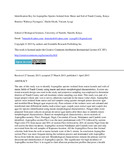| dc.contributor.author | Ayugi, Vincent | |
| dc.contributor.author | Okoth, Sheila | |
| dc.contributor.author | Nyongesa, Beatrice W | |
| dc.date.accessioned | 2015-06-13T09:33:15Z | |
| dc.date.available | 2015-06-13T09:33:15Z | |
| dc.date.issued | 2015 | |
| dc.identifier.citation | Nyongesa, Beatrice Wabusya, Sheila Okoth, and Vincent Ayugi. "Identification Key for Aspergillus Species Isolated from Maize and Soil of Nandi County, Kenya." Advances in Microbiology 5.04 (2015): 205. | en_US |
| dc.identifier.uri | http://file.scirp.org/Html/1-2270507_55282.htm | |
| dc.identifier.uri | http://hdl.handle.net/11295/84723 | |
| dc.description.abstract | The aim of this study was to identify Aspergillus species isolated from maize kernels and soils of maize fields of Nandi County using macro and micro morphological characteristics. A cross sec- tional research design was used in the study and purposive sampling was employed to determine districts of Nandi County and sub locations where sampling was done. This study was part of a larger project whose aim was to survey aflatoxin exposure in the maize value chain. Aspergillus species were isolated from maize and soil samples using quarter strength potato dextrose agar and modified Rose Bengal agar respectively. Pure cultures of the isolates were sub cultured and transferred onto differential media; malt extract agar, czapek yeast extract agar and czapek dox agar for species identification using macro morphological characteristics. Fungal slides were prepared from pure cultures on potato dextrose agar media after three days to identify micro morphological characteristics. Based on morphological characteristics, seven sections of Aspergillus namely: Flavi, Fumigati, Nigri, Circumdati, Clavati, Nidulantes and Candidi were identified. Aspergillus section Flavi was the most predominant with 57% followed by section Nigri with 27% from maize and 58% of section Flavi followed by 26% of section Nigri from the soil across the three locations. Aspergillus sections Nidulantes and Candidi were rare and only recovered from the soil samples of Kaptumo location. All the Aspergillius flavus that formed sclerotia both from the soils or maize kernels were of the L strains. In conclusion Aspergillus section Flavi was most frequent during the isolation process and dominated with Aspergillus flavus from both the maize and soil. Morphological characteristics remain the primary tool for detection and identification of Aspergillus species. The significance for high incidence of Aspergillus section Flavi is in regard to their aflatoxin production profiles that poses a health threat to the community and it is of public health concern. Morphological characteristics as a primary tool for Aspergillus identification should be embraced and more personnel with the knowledge are required since modern and faster tech- niques are scarce and expensive. | en_US |
| dc.language.iso | en | en_US |
| dc.publisher | University of Nairobi | en_US |
| dc.title | Identification Key for Aspergillus Species Isolated from Maize and Soil of Nandi County, Kenya | en_US |
| dc.type | Article | en_US |
| dc.type.material | en | en_US |

